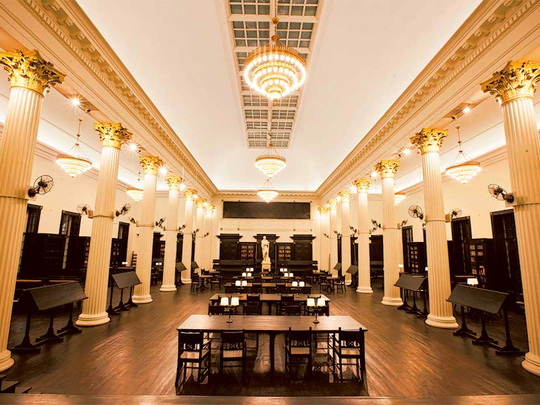
Mumbai: Even as the refurbishment of the wide steps leading to the city’s most iconic building, the 184-year-old Asiatic Society of Mumbai, will be completed in six weeks, the recently restored Town Hall and library within has become the focus of admiration.
Regular visitors are thrilled at the new, restored look that transports readers into an opulent era of chandeliers, dark wood furniture and shiny floors. The best part is that readers can now enjoy good lighting — a result of skill and art on the part of the designer.
When Chief Minister Devendra Fadnavis inaugurated the renovated Town Hall a few days ago, he remarked that Mumbai gets back its Town Hall retaining its old grandeur. Dedicating this prestigious heritage structure to Mumbaikars, he appealed to people visit the library with such a historic collection.
Town Hall has been classified as a Grade I heritage building among the list of Mumbai’s finest architectural masterpieces under the Heritage Regulations of Greater Bombay.
This was one of the first buildings for which the Maharashtra government sanctioned funds towards conservation and appointed Abha Narain Lambah Associates for taking up this task of restoring it.
“The first phase started in 2009, which focused on the structural restoration of the roofs and waterproofing,” said Kruti Garg, Director, Conservation, at the architectural firm.
The roof of this building was never opened and the condition of the wooden trusses were in a highly deteriorated state with cracks and deflections ranging from 8 inches to 21 inches, she told Gulf News.
“These would not have lasted another monsoon in Mumbai and it was in time that retrofitting works were done from 2009-2011,” Garg said.
The next phase dealt with the restoration of the interior of Central Hall occupied by the Central Library. The work commenced in February 2015 and was completed in January 2017. It entailed the restoration of the false ceiling using original techniques; restoration of the wooden floor; removing layers and layers of paint from cast iron columns which were imported from England back in 1833; restoring the Corinthian capitals and bringing them back to their original colour scheme of ivory and gold.
Even the furniture, “has been made new based on original designs and details and nuances found in the building to reflect the time period and character of the historic interior,” Garg said.
Lambah said that the relationship Mumbaikars share with their heritage is distinct from that other Indian cities where such historic buildings are fenced off from visitors.
In a newspaper article, Lambah wrote, “It is most likely that you as a Mumbaikar would have been born in a heritage hospital building [Bhabha, JJ, Grant Medical, Wadia hospital], gone to school or college in a heritage building [J B Petit, Avabai Petit, Cathedral, Bombay Scottish], graduated from a historic college or university [JJ School of Arts, SNDT Kanyashala, Elphinstone, St Xavier’s, University Fort Campus], played cricket in a historic ground [Oval, Shivaji Park], worked in a heritage building [HSBC and Deutsche Bank, BMC head office, Mantralaya and even Old Customs House] or even fought a court case in one.”
Any restoration or renovation to such historic buildings always bring on a feel-good smile on a Mumbaikar’s face.











